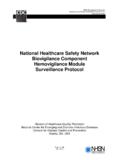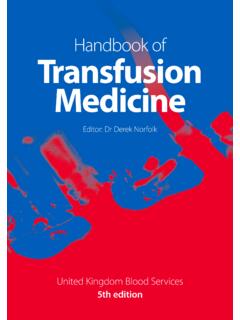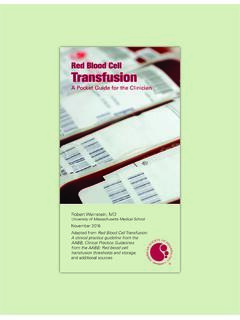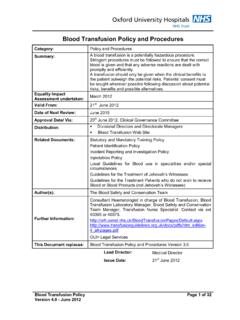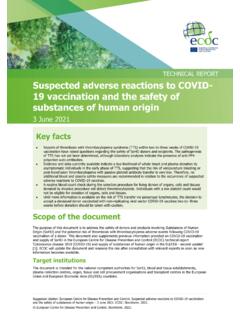Transcription of Fresh Frozen Plasma Transfusion- Guideline for practice
1 CAUTION: You must refer to the intranet for the most relevant version of this policy Fresh Frozen Plasma transfusion - Guideline for practice Central index 0329 29th April 2009 1 Fresh Frozen Plasma transfusion - Guideline for practice Sharepoint Location Clinical Policies and Guidelines Sharepoint Index Directory General Policies and Guidelines Sub Area Haematology and Blood transfusion Key words (for search purposes) Central Index No 0329 Endorsing Body Blood transfusion Committee Endorsement Date 29th April 2009 Review Date 29th April 2012 Lead author and designation Dr Kanchan Rege, Martin Drury and Kaye Bowen (if under review) Review led by CAUTION: You must refer to the intranet for the most relevant version of this policy Fresh Frozen Plasma transfusion - Guideline for practice Central index 0329 29th April 2009 2 Fresh Frozen Plasma transfusion - Guideline for practice Background Fresh Frozen Plasma (FFP) for adult use is produced from voluntary blood donations collected in the UK.
2 FFP for use in paediatrics is collected from non UK donors, to reduce the risk of transmission of variant CJD. The Plasma is then virally inactivated by treatment with Methylene Blue or solvent detergent, to reduce the risk of transmission of pathogens. The indications for the use of FFP are limited but are primarily to provide clotting factors to prevent bleeding due to coagulopathy. The risks of transmitting infection are similar to those of other blood components unless specialised pathogen reduced Plasma is used. Of particular concern are allergic reactions and anaphylaxis, transfusion related lung injury and haemolysis from transfused antibodies to blood group antigens especially A and B. Purpose of the document The purpose of this document is to give guidance to clinical staff who may be involved in the requesting, prescription or administration of Fresh Frozen Plasma in Peterborough and Stamford Hospitals NHS Foundation Trust. Content 1 Indications for use of Fresh Frozen Plasma Replacement of a single clotting factor deficiency when a virus free fractionated product is not available.
3 Acute Disseminated Intravascular Coagulation (DIC) in the presence of haemorrhage and a documented coagulopathy. Thrombotic Thrombocytopenic Purpura (TTP) usually in conjunction with Plasma exchange. Massive transfusion and surgical bleeding; the use of FFP should be guided by timely tests of coagulation. Haemorrhagic disease of the newborn; FFP 10-20ml/kg and Intravenous Vitamin K should be given Reversal of Warfarin effect. In the presence of life threatening bleeding, FFP only has a partial effect and is not the optimal treatment; Prothrombin Complex Concentrates (Octaplex) are preferred for life threatening bleeding. Consideration should also be given to vitamin K administration- refer to trust guidelines on the use of Octaplex (Prothrombin complex concentrate/PCC) for rapid reversal of warfarin in association with life threatening bleeding for more information on warfarin reversal. There is no role for FFP to correct abnormal coagulation results in the absence of bleeding unless before an invasive procedure.
4 CAUTION: You must refer to the intranet for the most relevant version of this policy Fresh Frozen Plasma transfusion - Guideline for practice Central index 0329 29th April 2009 3 Please note that FFP will only be thawed for immediate use, not on standby 2 Dose and group FFP is issued according to weight at a dose of 12-15ml/kg, which equates to 2-4 packs for an adult (one pack has an approx volume of 270-320 mls and is equivalent to 2 standard FFP units). For adults, FFP should be prescribed as individual units/packs/or bags NOT as a quantity in millilitres. If profuse bleeding is encountered, 2 packs of FFP may be issued, but a FBC and coagulation sample MUST be taken to ascertain future requirements The PT and APTT should be monitored and kept below x normal control (refer to trust policy for massive blood loss) Patients born after 1st January 1996, and all patients under 16 years old should only receive virally inactivated FFP, this is Methylene blue or solvent detergent treated FFP from non-UK donors Group compatible FFP should be used where possible.
5 FFP which is not of the same ABO group should only be used if they contain no high-titre anti A or anti B RhD (D) positive Plasma may be given to RhD (D) negative females of childbearing potential. Anti D prophylaxis is not required The prescription should ideally be made on the dedicated blood product prescription chart. 3. Administration FFP should be administered through a 170-200 m filter (standard blood giving set). A filter is required for the giving of FFP via a syringe for neonatal transfusion . The FFP pack should be visually inspected for pack integrity and discolouration prior to transfusion . Check that packs do not appear grainy or more cloudy than usual. If in doubt, DO NOT TRANSFUSE and contact the transfusion laboratory for advice. All patients receiving FFP must wear a trust ID band. The patient s identity must be checked by 2 members of staff prior to commencement of the Weight / kg Units of FFP to be given 50 2 60 3 70 3 80 4 90 4 100 5 CAUTION: You must refer to the intranet for the most relevant version of this policy Fresh Frozen Plasma transfusion - Guideline for practice Central index 0329 29th April 2009 4 transfusion .
6 The details on the tag attached to the FFP pack must be checked against the details on the patients ID band. In addition, the patient should be asked to confirm their name and date of birth, if they are able to do so. FFP takes approximately 20- 30 minutes to thaw, and for maximum efficacy. should be administered as soon as possible after thawing. Start the transfusion as soon as the pack is received from the blood fridge. Return unused packs to the transfusion laboratory for safe storage if transfusion is not started within 30 minutes of removal from the fridge. FFP packs are stored at 4 C once thawed, and must be used within 24 hours of thawing- there will be a note to this effect on the compatibility form issued with the pack. In adults each pack should be given over 20-30 minutes, though more rapid infusion may be required in major bleeding. In paediatrics, the recommended rate of transfusion is 10-20ml/kg/hr. Inform the patient of possible complications of transfusion , and the importance of reporting any adverse effects.
7 A number of reactions may follow FFP transfusions. They are the same as those which can occur after the transfusion of red cell concentrates including:- Febrile reactions Urticarial reactions Anaphylactic reactions Reaction to a bacterially contaminated unit. Follow the same baseline, 15 minute and post transfusion observation checks as for red cell transfusions. If a reaction is suspected, STOP THE transfusion , and inform medical staff and the transfusion laboratory immediately. An adverse event and transfusion reaction form must be completed. References British Committee for Standards in Haematology 2004 Guidelines for the use of Fresh Frozen Plasma , Cryoprecipitate and Cryosupernatant. British Journal of Haematology 126(1): 11-28 British Committee for Standards in Haematology 2007 Amendment to the Guidelines for the use of Fresh - Frozen Plasma , cryoprecipitate and cryosupernatant Available;- British Committee for Standards in Haematology 2006; Guidelines on the Management of Massive Blood Loss British Journal of Haematology 135(5): 634-41 McClelland D (editor) (2007) Handbook of transfusion Medicine (4th ed).
8 London, TSO
